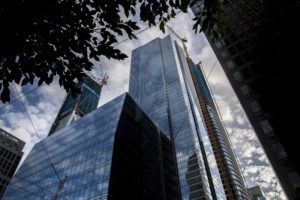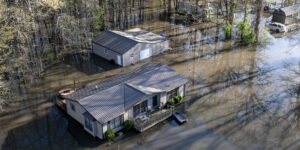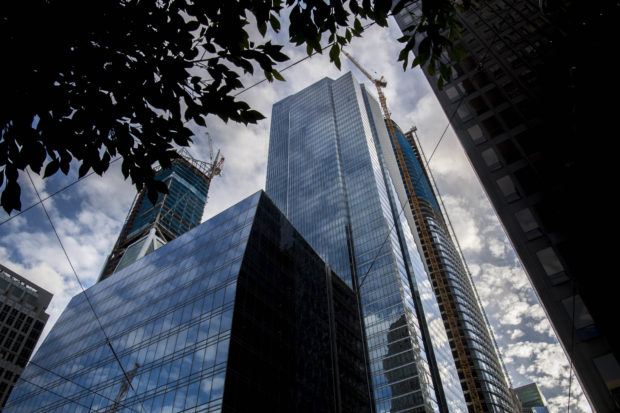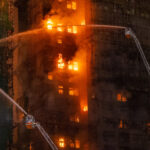
Nina Agabian, a retired director of research in global health science at the University of California, bought a 29th-floor apartment in San Francisco’s Millennium Tower in 2010. “It was supposed to be a wonderful building,” she said in January, sitting in a leather chair in the building’s vast, low-lit, owner’s-club level. “For many of us, who left our business lives to start our older years, this had become a nice, comfortable place.”
The building, which opened in 2008 and was touted as the most luxurious tower in San Francisco, became a beacon of the city’s burgeoning wealth, attracting tech millionaires, venture capitalists, and even the San Francisco 49ers retired quarterback Joe Montana.
The 58-story tower’s shine faded on May 10, 2016, when Agabian attended a homeowners association meeting and was informed that the building had sunk 16 inches into the earth and tilted over 15 inches at its tip and 2 inches at the base, according to suits filed by residents and the city of San Francisco. “You can imagine how distressed we were to know that, for one, our lifetime investment and savings are at risk,” she said. “And we have no idea whether or not there’s a fix to it, and if there is a fix to it, what it will entail.”
The building, meanwhile, continues to sink.
As Agabian and more than 20 other residents file multiple lawsuits against the building’s developer, the city of San Francisco, and the Transbay Joint Powers Authority, another, potentially more ominous development has emerged. Two people with knowledge of Millennium Partners’ liability policy say the developer is insured to cover some $100 million in damages caused by settlement or construction defects; the policy is split among several insurers. Ancillary policies held by the building’s architect, structural engineer, and general contractor are worth another $50 million to $100 million, according to one of the people. Any legal fees incurred by the policyholders could be deducted from their policies. But according to experts, fixing whatever is causing the building to tilt could cost far more than that amount.
Further adding to residents’ woes is that it’s not even clear if coverage will be available under the liability policy: It might have been voided by the flaws in the building.
“I don’t foresee a scenario where anyone writes a check under any policy,” said Sarah Sherman, the U.S. property practice leader at JLT Specialty USA, an insurance broker in San Francisco. “There’s no way to avoid litigation at this point.”
It’s possible, in other words, that homeowners already under water on their damaged real estate investments may have to cover millions in costs to repair the building. And that’s not even the extreme worst-case scenario—in 1989, some buildings on loose San Francisco soil collapsed during an earthquake. The city has asked Millennium Partners for information on how much the building can further settle without compromising the building’s stability and how it will perform during a quake. In a letter dated January 13, 2017, MP declined to supply the city with that data, citing ongoing litigation and mediation.
“I don’t want to be in a situation in two years where we look back and think we really could have done something to prevent a terrible situation,” warned San Francisco Superior Court Judge Curtis Karnow at a January 13. If such a terrible situation occurs, there is little clarity as to who would pay for the damage.
“Let’s say there’s an earthquake and there’s major damage, the insurer will fight like hell not to pay the claim,” Sherman said. “I would not be pleased if I was in that building.”
Surrounding the building is the $1.1 billion new Salesforce Tower, the new condominium tower 181 Fremont, and a neighborhood bar.
While the best method of fixing the building’s tilt won’t be known until an engineering firm hired by the developer completes its investigation— and perhaps not even then— the cost is certain to be millions, and perhaps hundreds of millions, of dollars. Conservatively, “I think it’s fair to say that you’re at least in the tens of millions of dollars,” said Joe Maffei, who noted that his San-
 Francisco-based structural engineering firm is not associated with project. Stopping the settling would be very expensive, he explained, and then you have the added expense of actually evening out the building’s base. (A recent study released by the city which examined the fire safety, disability access, plumbing and electricity, declared the building “remain[s] safe for occupancy at this time.”)
Francisco-based structural engineering firm is not associated with project. Stopping the settling would be very expensive, he explained, and then you have the added expense of actually evening out the building’s base. (A recent study released by the city which examined the fire safety, disability access, plumbing and electricity, declared the building “remain[s] safe for occupancy at this time.”)
Beyond their lawsuits, the residents can’t hope for recourse from the developer.
“Millennium Partners doesn’t own the building,” said P.J. Johnston, a spokesman for the developer. “Even if there was an immediate and agreed upon measure to take, the building is owned by homeowners. Millennium Partners cannot just move forward with any set of measures” to fix the building, he said.
Castle in the Sand
Since the mid-19th century, the city of San Francisco has expanded its shoreline by dumping debris into its coastal marshlands and transferring sand and clay from the ocean bed onto land. Much of downtown San Francisco, including parts of Mission Street, where Millennium Tower was built, is constructed on this loose, wet soil. But the city’s proximity to two major faults—the San Andreas and the Hayward—could render that same ground unstable in an earthquake, said Keith Knudsen, the deputy director of the U.S. Geological Survey’s Earthquake Science Center. “The soft material tends to amplify the parts of the shaking—the earthquake’s wavelengths—which are damaging to buildings,” he said.
The engineers who designed Millennium Tower were aware that the building sat on unstable soil and constructed the 645-foot tower’s base so it would behave “dynamically” in the event of an earthquake, at least partially withstanding the shocks on the unstable ground. To achieve this effect, they chose a support known as “friction piles,” a series of rods bored into the ground that would help stabilize the building as the earth rocked. While other buildings in the area were built with similar foundations (and still others use pilings drilled all the way down to firmer bedrock), the majority of the skyscrapers in downtown San Francisco are built with steel frames. Millennium Tower, in contrast, is made of vastly heavier concrete.
A decade after the first piles were drilled, walls in the underground parking garage have begun to crack due to the shifting, marble floors in the lobby have begun to buckle, and residents have complained that the ventilation units have begun to fail, raising questions about when the tilt will stop, or if it will stop at all.
Sold Out
Sales for Millennium Tower started around November 2007. By 2013 the building was fully sold for a reported total of $750 million; an April 5, 2013 article in the San Francisco Business Times, which Millennium Partners posted on its website, quoted the building’s costs at $600 million.
In the same story, Richard Baumert, a partner at the company, sounded a triumphant note. “We saw it through and in the end our plan and vision for the project were validated,” he said. The building’s appeal, he continued, was “not as much about the physical structure as the residential experience.”
The article also quoted Gregg Lynn, a broker at Sotheby’s International Realty who reportedly represented about a dozen Millennium Tower buyers. “The situation we are facing is that everybody wants to buy into that building, and they are kicking themselves that they didn’t when they had the chance,” he said. “People who sell now are expecting to cash out with major profits.” The golden era for the Millennium Tower would last less than three years.
Problems Emerge
No one is quite sure why the building began to sink and tilt. It could be a flaw in the structure, which would make it Millennium Partners’ responsibility, according to the building residents, or the result of the nearby construction of a major transit station, which would make it at least partially the responsibility of the station’s builder. Possibly, it could be some combination of the two.
A class-action by 20 building residents, led by their fellow resident, patent litigator Jerry Dodson, alleges that Millennium Partners knew the building had sunk 8.3 inches into the ground by 2009, the year after it was completed.
“There’s the possibility that when they poured [the concrete base] in 2006-07, that it immediately sank,” Dodson said in an interview in his living room in the tower, which is filled with art-deco vases and sculptures and overlooks San Francisco Bay. “It’s extremely unlikely in my mind that as we began 2009 that it immediately tilted 6 inches to the northwest. What’s more likely is they poured the [slab] on unstable soil.”
Millennium Partners denies responsibility for the tilting. “At the time of its completion in 2008 and throughout its entire sales process, [Millennium Tower] had settled within predicted, safe ranges,” said Johnston, the developer’s spokesman.
Dodson’s 20 homeowners, who collectively paid some $75 million for their condos, claim that the developer hid the building’s faulty structure from prospective buyers and that the city’s administrators joined in the alleged fraud by helping conceal the tower’s engineering flaws as early as February 2009 by signing mutual nondisclosure agreements. The two colluded over half a decade to keep Millennium Tower’s design defects secret to allow the city to move forward on its own construction in the neighborhood, according to Dodson’s complaint. The city and Millennium Tower deny these allegations
Another target of Dodson’s suit is the Transbay Joint Powers Authority (TJPA), which is building what it calls a “Grand Central Station of the West” next door to Millennium Tower. Part of the development, which also includes towers and below-ground rail tunnels in the soft soil, could have undermined Millennium Tower’s foundation, causing the building to tilt, according to Dodson’s complaint. If TJPA is found to be at fault, San Francisco taxpayers could be obliged to fund the tower’s repair. The developer blames TJPA for the tilt. The TJPA has denied the allegations.
The TJPA attempted to dismiss one lawsuit Millennium Tower residents filed by claiming that the tower was still structurally secure. In a move critics attributed to the city’s desire to absolve itself of any blame surrounding the project, the San Francisco Attorney’s office subsequently sued Millennium Partners on behalf of TJPA.
Regardless of who is legally responsible, all parties have finally agreed that there is, in fact, a problem.
A report commissioned by Millennium Partners and published in 2014 by the engineering firm Simpson Gumpertz & Heger determined that the building’s support columns and foundation were experiencing “significant stress.” Nevertheless, the report concluded: “With the exception of the foundation,” it read, “none of the settlement-related demands on these elements are at levels that indicate impending failure.” The building’s supports might be cracking, in other words, but—as of a few years ago, at least—it was unlikely to collapse.
Potential Solutions
Recently, Millennium Partners entered private mediation with building residents, with the goal of halting environmental damage and to “stop any undue further settlement of the building,” according to the developer’s spokesman. As far as Millennium Partners is concerned, the culprit is the TJPA project next door. “We need to ensure that the damage being caused by our immediate neighbors, TJPA, is stopped,” he added.
The Oakland firm Sage Engineers has been hired by Millennium Partners to investigate the foundation, but as yet the firm hasn’t offered potential solutions. Inspiration might come from the 1998 case of the Mandalay Bay hotel-casino in Las Vegas, which sank almost 19 inches as its weight displaced water from an underlying aquifer. The solution was to drill 536 metal cylinders underneath the casino’s 43-story tower, which stabilized the edifice at the cost of between $8 million and $10 million, according to a 2000 article in the Las Vegas Sun.
Several engineers and developers contacted by Bloomberg suggested a similar methodology—the insertion of slender, 5-inch to 12-inch supports called “micropiles” beneath Millennium Tower’s existing foundation—could be effective. Engineers might “have to go down to the bottom of the garage and drill through the mat slab,” said Jake Albini, the senior manager of real estate development at Jay Paul Co., which is developing a 70-floor, mixed-use skyscraper neighboring Millennium Tower. “It’s not an easy task, but nothing’s impossible.”
But Steven Sanders, the president of Sage Engineers, cautioned against jumping to conclusions. “You have to be very careful about these different fixes,” he said. “They’re very dependent on soil conditions and building types.” Millennium Tower, he said, is fairly unique. “It may be tough to really go down the road and identify possibilities based on historical knowledge,” he said. “I think it would be hard and probably dangerous to say, This is done here, why don’t you do the same thing there?”
Resale Quagmire
Any fix to the building will almost certainly take several years, and the lawsuits over who will pay for it could take even longer. In the meantime, residents of the building remain in limbo.
“There haven’t been a lot of resales in the building since all of this news came out,” said Gregg Lynn, the Sotheby’s broker. “There’s still no clarity about what it takes to fix or stop the problem.”
“We can’t sell, we can’t rent, we can’t move,” said Agabian, the retired scientist. “I’d sell it in a second if I got fair market value for it.” She corrected herself: “Well, there’s not a fair market for it, because now the fair market for it is zero.”
Lynn recently sold deceased venture capitalist Tom Perkins’s Millennium Tower penthouse for $13 million but noted that it was purchased by an existing resident and was a unique transaction. The buyer “was aggressively convinced that this problem is solvable,” Lynn said, and felt that the apartment was a bargain. (Perkins purchased the apartment for $9.4 million and reportedly spent another $9 million renovating it.)
Other residents are stuck.
“I’m getting a lot of calls from homeowners in the building who want to make plans to list their places once the settlement solution is announced,” Lynn said, adding that he had close to 25 clients in the building. “What we’re waiting for is the public announcement for what the solution to the structural concerns might be and how it’s going to be paid for.” It’s the latter question, Lynn said, that could be the hardest to answer. “The second [question’s] answer is going to be mired in litigation for five to 10 years,” he continued. “But from what I hear from people at the top, this is very fixable—we just don’t know when the solution is going to be announced.”
That’s fine for residents who want to stay put—people are “absolutely passionate about it, the service there is extraordinary, and the HOA is extremely well-run,” Lynn said—but there are many others who are hoping to move yet are unwilling to sell at fire-sale prices. “I can’t tell you what percentage down the values are,” Lynn said, “because nothing is trading.”
Currently, just three apartments are on the market: apartment 4E, which has 1,136 square feet and is listed at $1.299 million, or $1,143 a square foot; it last sold in 2013 for $915,000. There’s also penthouse 1A, which is 2,706 square feet and is listed at $8.995 million, or $3,324 a square foot; it’s been on the market since July and last sold in 2014 for $3 million. The final apartment, 14C, is a one-bedroom, one-bathroom space with 833 square feet. It’s on the market for $1.08 million, or $1,296 per square foot, and was listed in December. It last sold for $790,000 in 2012.
These can be compared with other new-construction luxury towers, such as the residences at the St. Regis, the Four Seasons, and 181 Fremont, which is still under construction. These properties, whose price per square foot range from about $1,400 to more than $3,000, continue to sell—condos sold at the Four Seasons in October for $11.7 million, at the new development One Rincon Hill for $3.7 million in November, and in the refurbished loft development 6 Mint Plaza for $2.5 million in December, according to Lynn’s 2016 San Francisco Condo Report—while Millennium Tower residents have been forced to wait on the sidelines, fretting about whether they’re sitting on significant assets or a stratospheric liability.
“Everyone at this building is forced to bring the players to the table,” said Agabian. “No one has stepped up, not Transbay, nor the city, nor Millennium Partners has done anything to fix this, and we’re left holding the bag of you-know-what.”
Updates ninth paragraph with quote from Judge Curtis Karnow. Updates the 12th paragraph with details from a recent safety report.





















 How One MGU Grew Fivefold When Capacity Fled Cat-Prone Property Markets
How One MGU Grew Fivefold When Capacity Fled Cat-Prone Property Markets  Hong Kong Fire Reveals Contractor Safety Breaches, Residents’ Revolt
Hong Kong Fire Reveals Contractor Safety Breaches, Residents’ Revolt  Viewpoint: Agentic AI Is Coming to Insurance Industry – Much Faster Than You Think
Viewpoint: Agentic AI Is Coming to Insurance Industry – Much Faster Than You Think  Demystifying the Data Landscape: Lake, Warehouse and Lakehouse Explained
Demystifying the Data Landscape: Lake, Warehouse and Lakehouse Explained 






